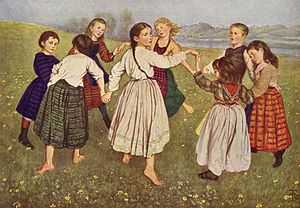Performing arts education

Education in the performing arts is a key part of many primary and secondary education curricula and is also available as a specialisation at the tertiary level. The performing arts, broadly dance, music and theatre are key elements of culture and engage participants at a number of levels. This engagement through participation and formal and informal education is often lifelong.
The end point for performing arts education varies, for some people it is part of their engagement in their own and others culture, such as that of indigenous peoples and folklore, for others it leads to professional careers up to an elite level.
For this latter group, depending on the discipline, the physical demands are such that early entry into training can be essential. This is seen particularly with classical ballet and circus arts.
Performing arts are often a core curriculum area in education and seeks to expose students to ways to "express ideas and emotions that they cannot express in language alone". The curriculum needs to be sequential, from preschool to high school, to develop "students’ skills and understanding of creating, performing, and responding", to "promotes knowledge and understanding of the historical and cultural contexts of the arts" and provide opportunities for students to make connections among the arts, with other disciplines within the core curriculum, and with arts resources in the community.[1]
The performing arts
The performing arts differ from the plastic arts insofar as the former uses the artist's own body, face and/or presence as a medium Performers often adapt their appearance by special clothing, stage makeup, etc.
The breadth of areas covered by the performing arts is wide, including:
- Acting - actor, comedian, etc.
- music - singer, musician, etc.
- busking
- opera
- dance - dancer
- Circus skills
- marching arts
- performance art a specialized form of fine art in which the artist performs his or her work live to an audience
Prominent providers of performing arts education
Australia
- Helpmann Academy
- National Institute of Circus Arts
- National Institute of Dramatic Art
- Western Australian Academy of Performing Arts
India
- The Kerala Kalamandalam,a deemed university in Kerala is a major centre for learning Indian performing arts.
UK
- The Royal Academy of Dance (RAD) has over 15,500 members in 82 countries. It was founded in 1920.
- The Royal Ballet School founded in 1931 is a specialist co-educational school in London, England. It combines a mainstream academic education with an intensive dance training.
- The Royal Academy of Dramatic Art (RADA) founded in 1904 in Bloomsbury, London, is generally regarded as the most prestigious drama school in the United Kingdom.
- The London Academy of Music and Dramatic Art (LAMDA) founded in 1861 it is the oldest drama academy in the world producing some of the worlds top entertainers.
USA
- The School of American Ballet, Lincoln Center is located in New York City, United States is the official academy of the New York City Ballet
- Un-Cabaret Laboratories teaches alternative comedy writing & performance
- The Juilliard School in New York City provides an arts education for people around the world since 1905, and has trained hundreds of famous actors that have performed on Broadway and in American films for the past century.
- New Orleans Center for Creative Arts (NOCCA)
- Leland Powers School in Boston provided training in theatre, public speaking, opera, and more for more than 50 years.
- The Los Angeles Academy of Performing Arts (LAAPA)
- The National Conservatory of Arts (NCA) in Washington, DC National Conservatory of Arts is a performing and fine arts conservatory that offers classes and private lessons in Music, dance, art, theater, and foreign language. NCA also hosts a performing arts after school program, and summer camp, where students major in specific art forms, or participate in all of the programs throughout the week. NCA, also houses the National Girls Choir, which is dedicated to presenting the finest in choral performance and education for girls and young women. NCA also offers music teacher mentorship programs, which allows music teachers with inexperience or credentials to shadow accomplished music teachers until they embody the same skill sets and standards.
Indonesia
- Bali School of Dramatic Art founded in Bali 2007 provides accredited arts education through LAMDA.
See also
- Category:Schools of the performing arts
- Category:Drama schools
- National Dance Institute
References
External links
- Arts in the Massachusetts Arts Curriculum Framework
- California Department of Education "Visual and Performing Arts Framework" Preschool to year 12